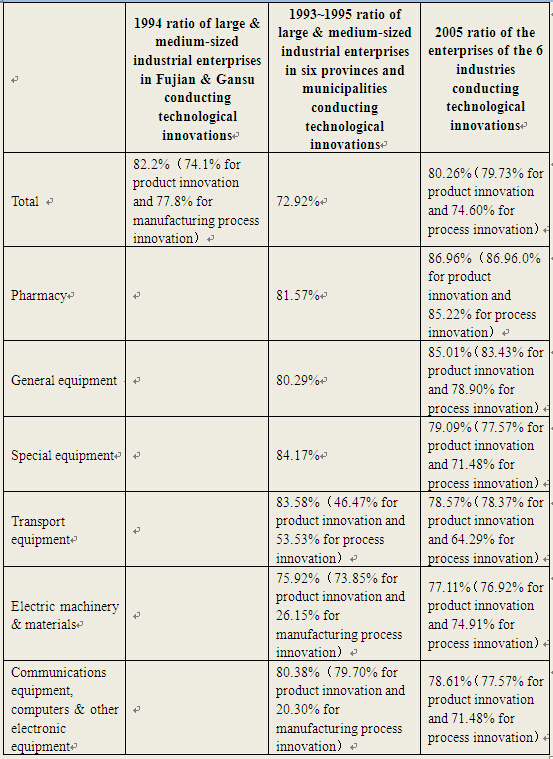Basic State and Main Features:Technological Innovations by China's Industrial Enterprises
May 06,2008
Feng Fei, Wei Jigang, Wang Xiaoming & Zhao Yuchuan, Research Department of Industrial Economy of DRC
Research Report No.198, 2007
In order to ascertain the state of the technological innovations of China's large and medium-sized industrial enterprises, the Research Department of Industrial Economy of the Development Research Center of the State Council, the Department of Economic Construction of the Ministry of Finance and the Department of Industry and Transport of the National Bureau of Statistics conducted a joint questionnaire survey over 2,655 enterprises in six major industries including pharmacy, general equipment, special equipment, transport equipment, electric machinery and materials, and communications equipment, computers and other electronic equipment. The survey results reflect the basic state and main features of the technological innovations of China's large and medium-sized industrial enterprises.
I. Basic State of Technological Innovations of Large and Medium-Sized Industrial Enterprises
1. Corporate technological innovations remain basically unchanged compared with that of ten years ago
Of the 2,655 enterprises surveyed, 80.26% have conducted innovations in various forms. This is an indication that innovations have been fairly active. In particular, the innovations in the sectors of pharmacy and general equipment have been most active, respectively accounting for 86.98% and 85.01% (Table 1).
Compared with the survey conducted in 1994 by the Development Research Center of the State Council and the National Bureau of Statistics in the two provinces of Fujian and Gansu and with the survey conducted in 1996 by the Ministry of Science and Technology and the National Bureau of Statistics over the technological innovation of the large and medium-sized industrial enterprises in the six provinces and municipalities of Beijing, Shanghai, Jiangsu, Guangdong, Liaoning and Harbin, the current survey indicates that the technological innovations of these enterprises are basically as active (the ratio of the enterprises conducting technological innovations) as they were (Table 2). The ratio is 5 percentage points higher on average in the sectors of pharmacy, general equipment, and electric machinery and materials, and 1~5 percentage points lower in the sectors of special equipment, transport equipment, and communications equipment, computers and other electronic equipment.
A comparison between the data of the three surveys on the technological innovations of China's industrial enterprises indicates that about 80% of the large and medium-sized industrial enterprises have conducted technological innovations and their technological innovations have been relatively active since 1994. On the other hand, it also reveals that the ratio of the enterprises conducting technological innovations has been basically unchanged and has shown no linear progressive development as the economic growth has done. About 20% of the large and medium-sized industrial enterprises have conducted no innovation at all and are staying where they were.
Table 1 Industrial Technological Innovation Activities in Past Three Years (%)

Table 2 Comparison between Technological Innovations of Large & Medium-Sized Industrial Enterprises

Note: Based on the statistical data of the survey conducted in 1994 by the Development Research Center of the State Council and the National Bureau of Statistics over 432 large and medium-sized industrial enterprises in the provinces of Fujian and Gansu.
Source: Report on Corporate Technological Innovations. The survey on the technological innovations in six provinces and municipalities conducted in 1993~1995 by the Ministry of Science and Technology and the National Bureau of Statistics covered 3,346 large and medium-sized industrial enterprises.
2. A few enterprises conduct original innovations, some enterprises conduct integrated innovations and most enterprises conducted imitative innovations focused on import of patent rights, proprietary technologies and purchase of equipment
Of the sample enterprises in the survey, about one half have conducted imitative innovations, one-third conducted independent innovations and about one-fifth conducted no innovations at all. Imitative innovation became the main form of technological innovation chosen by most enterprises. This conforms to the fact that most domestic enterprises do not have core technologies and lag behind the advanced technologies in the world.
Of the enterprises conducting independent innovations, only 4.79% have conducted original innovations and 36.38% conducted integrated innovations. Most enterprises have mainly relied on the import of patent rights and proprietary technologies and the purchase of equipment, respectively accounting for 57.93% and 52.58% of all the enterprises surveyed1. This is an indication that most Chinese enterprises are incapable or unwilling to conduct high-input and high-risk key technological innovations, some enterprises possess the capacity for integrated innovation and most enterprises are more willing to conduct innovations based on the import of technologies.
…
If you need the full text, please leave a message on the website.
1The reason why the total sum of different modes of innovation exceeds 100% is because the enterprises have conducted different forms of innovation simultaneously. The same reason applies to the following similar cases.














